Abstract
This study identifies the following three key factors controlling shale gas reservoirs in the lower Cambrian Niutitang Formation, northern Guizhou, China: sedimentary features, diagenetic modification, and stable tectonic conditions. This research addresses gaps in previous studies by investigating how tectonic and diagenetic conditions contribute to the unique characteristics of shale gas enrichment in tectonically complex areas with high thermal maturity (Ro > 2.5%). Sedimentary conditions revealed a positive correlation between total organic carbon (TOC) content and gas adsorption capacity, with higher TOC enhancing adsorption. Experimental data indicate that the TOC content (2.33%–9.07%) significantly correlates with methane adsorption capacity (Langmuir volume VL = 1.87–8.78 cm3/g at 30 °C and 10 MPa), as evidenced by the linear relationship between TOC and VL in shale samples. Clay mineral content exhibited a dual role as moderate levels (15%–25%) improved adsorption, while excessive amounts (>30%) reduced efficiency due to pore occlusion. Diagenesis, including compaction, cementation, and thermal evolution of organic matter, significantly reshaped reservoir porosity. Quantitative analysis of core samples demonstrates that compaction caused a porosity reduction of 18%–25% in samples with burial depths exceeding 1500 m, thereby influencing gas retention capacity. The reservoir has entered the anchizone (average vitrinite reflectance Ro = 2.54%), characterized by advanced organic matter maturation and widespread organic porosity development. Tectonic activity was critical for gas retention; intense tectonic activity led to shallower burial depths and gas loss, whereas structurally stable areas favored preservation. This study emphasizes the significance of tectonic conditions and their role in maintaining gas reservoirs in the anchizone, reconciling discrepancies in gas storage mechanisms observed in basins with similar TOC and thermal maturity. In summary, deep marine shale gas enrichment relies on the synergistic effects of high-quality sedimentary foundations (TOC > 4%, quartz > 30%), diagenetic evolution optimizing pore structures, and stable tectonic conditions ensuring gas retention. These findings provide new insights into the exploration of shale gas in complex tectonic regions and offer a framework for improving prediction models in shale gas enrichment by integrating micro-scale organic–inorganic interactions with macro-scale tectonic controls.
1. Introduction
As an important replacement field for conventional oil and gas resources, shale oil and gas has become a hot spot for global oil and gas exploration and development. Shale gas reservoirs represent a unique category of natural gas reservoir systems, characterized by the integration of both source and storage within a system dominated by organic-rich mud shale formations. The primary modes of storage in these reservoirs include adsorption and free-state accumulation. Zhao [1] pointed out that factors (e.g., sedimentary environment, thermal evolution, and tectonic activity) are the reasons for the large differences between the shale gas reservoirs of the Niutitang Formation and the shale of the Wufeng–Longmaxi Formation. Zou [2] thought that the four major controlling factors for shale gas enrichment and high yield include the sedimentary environment, thermal evolution, crack development degree, and tectonic preservation. Guo [3] proposed the binary enrichment theory of phased storage in deep-water sheds and controlled production under convenient preservation. This theory was applied to the exploration of high-evolution shale in the southern marine complex tectonic area, which discovered the Fuling atmospheric field. While previous studies have established foundational frameworks for shale gas reservoir evaluation [1,2,3], critical knowledge gaps persist in applying these theories to tectonically complex basins with high thermal maturity (Ro > 2.5%). First, the binary enrichment theory [3], though successful in the Fuling field, remains inadequately tested in regions experiencing multi-phase tectonic superimposition where preservation conditions dynamically interact with stress fields. Second, existing models predominantly emphasize macro-scale controls (e.g., sedimentary environment, fractures), yet lack quantitative integration of micro-scale organic–inorganic interactions—particularly how tectonic movement modifies adsorption capacities in overmature shales [4,5,6]. Third, the Niutitang-Wufeng/Longmaxi comparative analysis reveals lithofacies-dependent storage mechanisms but fails to resolve why similar TOC and thermal maturity values yield order-of-magnitude differences in gas content across basins [7,8,9,10]. This emphasizes the necessity of evaluating not only diagenetic processes but also the structural conditions as the latter play a crucial role in determining the long-term sustainability of shale gas reservoirs [11,12,13,14]. While high TOC and diagenesis are universal controls, basin-specific thermal-tectonic histories ultimately dictate shale gas enrichment [15,16,17,18,19].
The lower Cambrian Niutitang Formation, as a key stratigraphic unit for shale gas exploration in southern China, has its organic matter, clay mineral composition, and diagenesis significantly influencing shale gas accumulation [2,20,21]. Studies have shown that the organic matter in the Niutitang Formation is predominantly Type I kerogen, with the organic maturity being strongly affected by temperature and pressure, presenting complex thermal evolution characteristics. The thermal maturity is generally high, with vitrinite reflectance (Ro) typically ranging from 2.5% to 3.57%, indicating a high-overmature stage [1,22]. The hydrocarbon generation potential is notable, but in some areas excessive thermal evolution leads to a decline in hydrocarbon generation capacity. However, the development of organic porosity still provides space for gas storage. In terms of mineral composition, the formation contains high levels of siliceous and brittle minerals, with a maximum of over 60%, which is favorable for reservoir fracturing and microfracture development [3,23]. The clay mineral content is low, with illite and mixed layers of illite–smectite dominating. However, when the clay content in shale reservoirs is too high it may enhance plastic deformation and affect pore preservation. Changes in clay mineral composition reflect mineral transformations and chemical environment evolution during diagenesis, which directly impacts the physical properties of the reservoir and the pyrolysis potential of organic matter [24,25]. The primary storage spaces consist of organic porosity, interlaminar pores in clay minerals, and structural fractures. The porosity is generally of the very low porosity-permeability type, but in local “sweet spots” characterized by high TOC and siliceous enrichment larger pores can develop and gas content can reach 1.48 to 8.75 m3/t [26,27,28]. In terms of diagenesis, the deep-water shelf environment provides reducing conditions for organic matter enrichment, while thermal evolution promotes the formation of organic porosity and microfractures. Hydrothermal activities, such as siliceous input, further affect pore structures. Structural preservation conditions are crucial for hydrocarbon accumulation. Post-Indosinian uplift and erosion have led to the destruction and reduced sealing capacity of cap rocks in some areas and so it is necessary to prioritize regions with moderate burial depth and stable structures to ensure the integrity of gas reservoir preservation.
The Niutitang Formation has enormous shale gas resource potential, but exploration strategies should be optimized according to regional geological differences, with a focus on “sweet spots” characterized by high TOC, moderate thermal evolution, and favorable structural preservation conditions. The main control factors of shale gas reservoirs in the Niutitang Formation in northern Guizhou were, as discussed, from sedimentary material foundation, diagenesis and evolution, and tectonic preservation. This study introduces a revised theoretical framework that reconciles the discrepancies observed in gas storage mechanisms across basins with similar TOC and thermal maturity. The study incorporates the effects of evolving diagenetic conditions on reservoir evolution and links micro-scale organic–inorganic interactions with macro-scale tectonic controls, enabling a more precise prediction of gas content variations in overmature shales and the evolution of pore structures under tectonic influences. Understanding the interplay between sedimentary foundation, diagenesis, and tectonic stability is essential for optimizing exploration strategies in regions with complex geologic histories. This study enhances the understanding of the shale gas retention mechanisms and provides a broader context for future studies on shale gas reservoirs with similar geological conditions. Overall, these innovations not only fill critical knowledge gaps but also offer a robust tool for optimizing exploration strategies in tectonically complex basins.
2. Geological Setting
2.1. Tectonic Sedimentary Background of the Research Area
Northern Qianbei is located on the southeast edge of the Upper Yangtze craton basin (continental shelf), which is from the early Paleozoic. A global rapid maritime system appeared in the early Cambrian. The organic and siliceous black mud shales of the lower Cambrian Niutitang Formation are formed in the anoxic sedimentary environment of the deep-water shelf phase formed by the rapid rise in ocean currents [24,26]. The upper section of the Niutitang Formation is mainly composed of dark gray and gray mud shales, mixed with silty–sandy mud shales. The sedimentary environment of this section shows that the water body is relatively shallow and belongs to the typical shallow-water shelf sedimentary facies. In contrast, the lower section of the Niutitang Formation is dominated by thicker gray-black mud shale, which is rich in siliceous and carbonaceous components. The water body is characterized by its depth and anoxic conditions at the time of deposition, which facilitates the development of a deep-water shelf sedimentary phase. Additionally, this section of mud shale preserves a significant amount of siliceous microbial and algal fossils and is rich in organic matter. The organic matter thermal maturity of the Niutitang Formation shale is relatively high, with an average Ro value of 2.54, indicating that it is in the high-overmature stage and has entered the anchizone.
Shale of the lower Cambrian Niutitang Formation in northern Guizhou has undergone tectonic movements of varying stages and intensity. Tectonic movements since sedimentation are divided into three cyclical periods: Xuefeng–Caledonian, Haixi–Indochina–Yanshanian, and Himalaya [29]. The organic shale of the Niutitang Formation is quickly buried in the early stage of the Xuefeng–Caledonian cycle. Northern Guizhou was uplifted in its later period and sedimentation re-occurred during the Permian period. It experienced two continuous sedimentation and hydrocarbon evolutions during the Haixi–Indochina–Yanshanian tectonic cycle. The research area was in a stage of rapid uplift during the Himalayan tectonic cycle. The reservoir’s burial depth became shallow due to excessive uplift. Thrust faults on the east and west sides of the research area and the north have developed, and the faults are large in scale and extend far away (Figure 1). The tectonic trend and fractures are primarily oriented in the north-east direction, with the north-east–west direction of the fault being intersected by the northern fault. The formation time of these features is 200 Ma geological years later than that of the north-east-oriented structure. The central and southern faults are small in scale, with gentle formations.
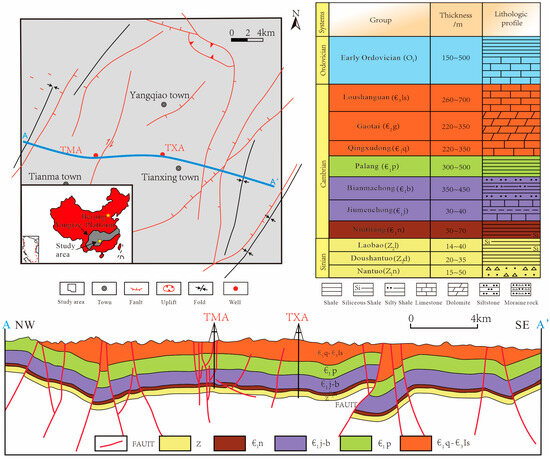
Figure 1.
Location and formation development characteristics of the research area.
2.2. Lithological Characteristics of Shale in the Niuhuitang Formation
2.2.1. Inorganic Mineral Components of Shale in the Niutitang Formation
Based on observations under scanning electron microscopy, sheet identification, X-ray diffraction, and energy spectrum analysis, the shale of the Niutitang Formation contains the following three types of inorganic mineral components (Table 1) [23]: minerals derived from land-source debris, minerals of chemical and biochemical origin, and minerals formed by hydrothermal processes. Notably, land-derived detritus and authigenic minerals constitute the majority of these components.

Table 1.
Genetic types of shale composition minerals in the Niutitang Formation.
Authigenic minerals and terrigenous clasts: Terrigenous clasts consist of quartz and clay minerals as well as a small amount of feldspar and mica in the shale of the Niutitang Formation. The quartz content in the mud is 10%–35%, with a particle size of 10–30 µm (Figure 2a). The authigenic clay minerals are mainly illite, with a flaky habit (Figure 2b). Most of the feldspar and mica have undergone dissolution and alteration (Figure 2c). The alteration of the mica is generally low, with well-developed interlayer gaps. The main products of chemical weathering are kaolinite and illite [30].
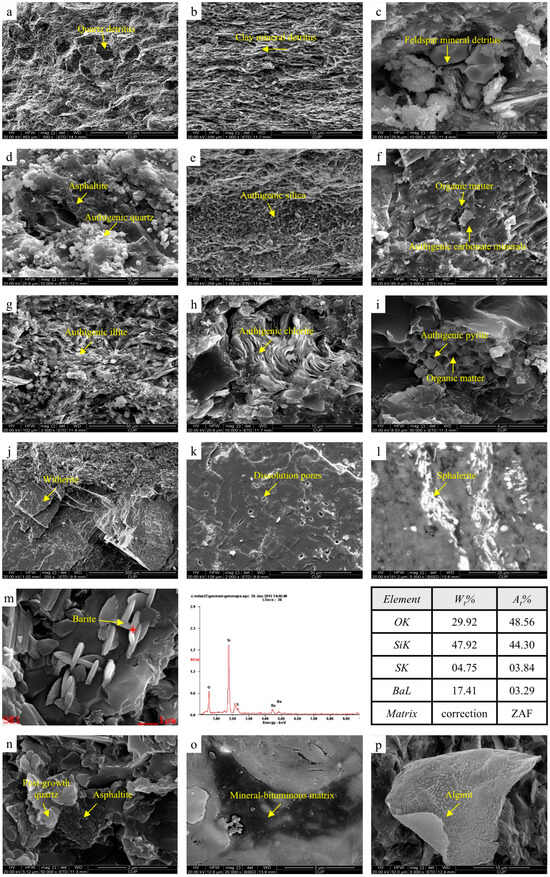
Figure 2.
Inorganic minerals and organic matter in the Niutitang Formation shale of the Cengong Block. (a) Quartz detritus, dispersed within argillaceous material, with underdeveloped intergranular pores. Well TXA, 1590.12–1590.22 m; (b) clay mineral detritus, predominantly illite, with clear bedding and bedding-parallel fissures. Well TXA, 1581.05–1581.15 m; (c) feldspar mineral detritus showing detrital feldspar and its alteration. Well TXA, 1804.81–1805.09 m; (d) authigenic quartz coexisting with asphaltite and exhibiting euhedral crystals and crystallites. Well TXA, 1775.56–1775.78 m; (e) authigenic silica, with siliceous bands distributed along the bedding. Well TMA, 1475.50–1475.55 m; (f) authigenic carbonate minerals coexisting with calcite and organic matter and showing a small amount of dissolution pores. Well TMA, 1450.37–1450.62 m; (g) authigenic illite resulting from the alteration of mica. Well TXA, 1804.81–1805.09 m; (h) authigenic chlorite, flaky in form. Well TMA, 1475.50–1475.55 m; (i) authigenic pyrit, with organic matter filling the intercrystalline pores of pyrite. Well TXA, 1788.57–1788.85 m; (j) witherite, rhombic in shape, with a stepped fracture surface and well-developed dissolution pores. Well TXA, 1813.70–1813.72 m; (k) magnified view of Figure 2j showing witherite and its dissolution pores. Well TXA, 1813.70–1813.72 m; (l) sphalerite, distributed in bands along bedding, with a Zn content of 63.00%. Well TXA, 1817.14–1817.49 m; (m) energy spectrum analysis of the hydrothermal mineral, Well TMA, 1445.18–1445.47 m, barite with a Ba content of 17.41% coexisting with silica; (n) asphaltite, Well TXA, 1788.57–1788.85 m, asphaltite with no fixed shape where the asphaltenes are tightly coeval with nanoscale post-growth quartz; (o) mineral–bituminous matrix, Well TXA, 1581.05–1581.15 m, asphaltite encapsulating minerals and an argon-ion polished surface; (p) alginit, Well TXA, 1560.92–1561.02 m, with clear surface ornamentation.
Minerals of chemical and biochemical origin: Shale in the Niutitang Formation contains abundant chemically- and biochemically-derived minerals, including common authigenic minerals such as quartz, silica, pyrite, calcite, and dolomite. Quartz, one of the significant authigenic minerals, coexists with bituminite (Figure 2d). Additionally, silica is abundant and closely associated with authigenic quartz. Both minerals are biochemically-derived and appear as irregular/spherulitic particles (Figure 2e). The coexistence of authigenic quartz, silica, and organic matter is notably close. Primary carbonate minerals are calcite and dolomite, predominantly in the form of micrite. Calcite exhibits smooth crystal faces, with stepped and conchoidal fractures observed in larger grains (Figure 2f). Authigenic clay minerals mainly include illite (Figure 2g) and chlorite (Figure 2h), which are mostly dispersed in low quantities. Illite, derived from the alteration of feldspar, mica, and rock fragments occur in sheets or clusters. Biogenic pyrite is also widely developed (Figure 2i) and its close association with organic matter reflects a strong connection to biological activity during its formation.
Hydrothermal minerals: Hydrothermal minerals, e.g., hydrothermal quartz (Figure 12a), witherite (Figure 2j), sphalerite (Figure 2l), and barite (Figure 2m) are developed in the shale of the Niutitang Formation. The Ba-rich minerals originate from sub-marine volcanic or hydrothermal vent sedimentation, and sphalerite and barite share similar origins. These hydrothermal minerals occur within the pores and fractures of shale.
2.2.2. Organic Matter Components in the Shale of the Niutitang Formation
Organic matter is a crucial component of shale, determining its hydrocarbon generation potential [31]. The pores and fractures of organic matter also serve as the primary reservoirs for shale gas. Scanning electron microscopy observations indicate that the maceral composition in the marine shale of the Niutitang Formation is predominantly sapropelic. This composition includes bituminite, a mineral–bituminous matrix, and algal–bacterial bodies, with bituminite being the most abundant and primary maceral component.
Asphaltite is a degradation product of aquatic lower planktonic algae and bacteria, possessing a strong hydrocarbon-generating capacity. It typically exists in a symbiotic relationship with authigenic minerals. Asphaltite is molded by minerals into irregular shapes or compressed into flat, smooth surfaces (Figure 2n). Furthermore, the mineral–bituminous matrix refers to a mixture derived from the sedimentary–diagenetic stage, which includes primary or contemporaneous finely dispersed organic matter encapsulating nano-sized minerals (Figure 2o). Alginite is defined as the remains of aquatic planktonic lower organisms with unicellular or multicellular biological structures [25]. They are common microfossils [32] and represent one of the significant hydrocarbon source materials. The late Sinian to early Cambrian period witnessed an unprecedented proliferation of microbial and algal organisms. The continuation of this ecological characteristic has led to the widespread development of microbial and algal structures within the lower Paleozoic shales, particularly in the lower Cambrian formation. Scanning electron microscopy at approximately 5000 x magnification allows for the observation of the complete morphology of individual microbial and algal structures, their surface ornamentation, etc., (Figure 2p).
3. Samples and Methods
3.1. Sample Collection and Preparation
In this study, twenty-four black shale samples from the Cambrian Niutitang Formation were collected from the drilling cores of wells TXA and TMA, as shown in Table 1. Geological samples should be collected with a minimum mass of 600 g, while rock and mineral samples should not be less than 500 g. Following core extraction, samples should be promptly selected, measured, and weighed with precision. Any impurities present in the samples must be thoroughly removed. To preserve the integrity of the samples, they should be rapidly packaged, sealed, and organized in accordance with the strata from which they were obtained. The entire process is supported by the internationally recognized SLIM laboratory data management system (grzglims.v2021.1), which ensures the seamless tracking of data from field sampling to laboratory analysis. The samples were air-dried, ground to a particle size of <80 mesh, and stored in dry containers to prevent contamination. The asphaltene reflectance test and rock pyrolysis test experiments were conducted using block core samples of 0.05–0.1 length (m)/100 diameter (mm), and asphaltene reflectance test samples of about 50 g/sample. All the samples were collected by SGS Unconventional Oil and Gas Technology Testing (Beijing) Co., Ltd. (Beijing, China) in January 2014 at the site for the purpose of the stratigraphic section samples. Prior to analysis, the samples were carefully prepared to maintain consistency for various tests. The experimental samples, sample labels, sampling depth, experimental content, and some experimental results are shown in Table 2.

Table 2.
Statistical of TOC, mineral composition parameters, Langmuir volume and Shale gas content for Lower Cambrian shale.
3.2. Geological Experimental Method
Total organic carbon (TOC) content measurement: The TOC content was measured using a LECO CS-230 carbon-sulfur analyzer (LECO Corporation, St. Joseph, MI, USA). Approximately 0.1 g of each powdered sample was combusted at 950 °C in an oxygen-rich atmosphere, and the released CO2 was measured by infrared absorption. Three measurements per sample were taken, and the average TOC value was reported. Mineral composition analysis by X-Ray diffraction (XRD): The mineral composition was analyzed with a SmartLab 9 X-ray diffractometer (Rigaku Corporation, Tokyo, Japan). Samples were finely ground and clay minerals were separated using a centrifugation method. XRD was performed over a 2θ range of 5° to 70° with a 0.02° step size. The quantitative analysis of minerals such as kaolinite, montmorillonite, and illite was performed by comparing XRD peak intensities with standard reference materials. The Rietveld refinement method was employed to obtain accurate mineralogical quantification. Helium porosity measurement: The helium porosity was measured using an HKC-2 helium porosity meter (Serve Real Instruments, Wuxi, China). The samples were vacuum-dried at 60 °C for 12 h to remove moisture. Total pore volume was determined under helium gas intrusion (pressure: 1 atm, temperature (22 ± 0.5 °C) with three independent measurements per sample (RSD < 1.5%), and the average porosity was reported. Nitrogen adsorption and pore structure analysis: Nitrogen adsorption was conducted using a Quadrasorb SI analyzer (Quantachrome Instruments, Boynton Beach, FL, USA) at liquid nitrogen temperature (−196 °C). The samples were degassed at 150 °C for 6 h under vacuum (<10−4 Pa) prior to analysis. The specific surface area (SSA) was determined using the BET model, with the P/P0 range set between 0.05 and 0.30. Pore size distribution (PSD) and mesopore volume (ranging from 2 to 50 nm) were calculated using the BJH model based on the adsorption branch. Data processing was carried out using the instrument’s MicroActive v3.01 software. Field emission scanning electron microscopy (FE-SEM): (Thermo Fisher Scientific, Waltham, MA, USA) A Quanta 200F FE-SEM was used to observe the microstructure of the shale samples. Samples were sputter-coated with Au/Pt (10 nm thickness, deposition rate: 5 nm/min) to ensure conductivity. Imaging was performed at magnifications of 5000×–20,000× under a high vacuum (<10−6 Torr). FE-SEM allowed for the examination of mineral morphology, pore structures, and the distribution of organic matter at high magnifications. The vitrinite reflectance (Ro) of bitumen was determined, utilizing a photometric microscope system equipped with calibrated oil-immersion objectives (50×) and monochromatic light (λ = 546 nm). Measurements were performed on polished whole-rock samples through point statistical analysis of bitumen particles under reflected light. For thermal maturity evaluation, rock pyrolysis analysis was conducted where 100 mg of crushed sample (<100 mesh) underwent programmed pyrolysis from 300 °C to 600 °C (25 °C/min) under a nitrogen atmosphere, with the S2 peak maximum temperature (Tmax) automatically recorded by flame ionization detection during the hydrocarbon cracking stage.
3.3. Laboratory and Quality Control
All tests were conducted at SGS (Beijing) Co., Ltd., an ISO17025-accredited laboratory [7]. Strict quality control protocols were followed to ensure the accuracy and reliability of the results. Calibration standards and reference materials were used throughout the testing process to minimize measurement errors and ensure reproducibility.
4. Results and Discussion
4.1. Sediments—The Foundation of the Reservoir
4.1.1. Mineral Composition and the Storage Space of the Organic Matter Control Reservoir
The average pore size in the reservoir of shale in the Niutitang Formation exhibits a significant relationship with mineral composition and organic matter content (Figure 3). The average pore size shows a strong exponential correlation with the TOC content [33]. The TOC content primarily influences micropores and mesopores below 5 nm. A substantial number of mesopores and micropores exist within the organic matter, which is favorable for natural gas storage. Since the organic matter content in the shale of the Niutitang Formation is closely related to quartz content, the average pore size exhibits a similar exponential relationship with quartz content, with a clear correlation. The clay mineral content is positively correlated with the average pore size [34]. The intercrystalline pores between clay minerals are mainly mesopores ranging from 2 to 8 nm, which can adsorb a portion of natural gas [35]. The TOC content in the shale of the Niutitang Formation is well-correlated with specific surface area. Asphaltite contains numerous spherulites, and the film-like, interwoven, and detrital organic matter covering mineral surfaces increases the specific surface area. Quartz is less affected by compaction due to its high hardness [36]. Thus, it shows a positive correlation with the specific surface area. The specific surface area is negatively correlated with the clay content, indicating strong compaction effects.

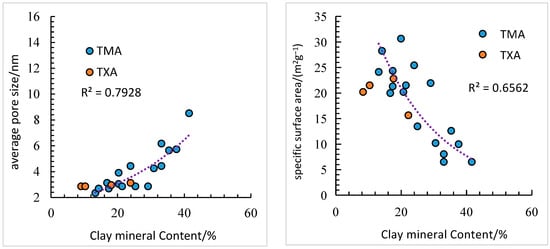
Figure 3.
Relationship between the spatial parameters of the shale reservoir in the Niutitang Formation and the TOC, quartz, and clay contents (Adapted from Wang et al., 2019) [37].
4.1.2. Mineral Components and Organic Matter Controlling the Gas Content of the Reservoir
Effect of mineral composition and organic matter on adsorbed gas: The adsorption capacity of shale is influenced by its pore structure [38]. The pore structure is governed by the mineral composition within shale [20]. Given that clay minerals possess a high volume of micropores and a substantial specific surface area, their contribution to the shale’s adsorption capacity is significant [39]. The adsorption capacity of clay minerals ranks as follows: montmorillonite > mixed layer illite/smectite > kaolinite > chlorite > illite (Figure 4) [27]. The total amount of clay minerals in the shale of the Niutitang Formation and the natural gas adsorption capacity initially increase and then decrease (Figure 5). Micropores in clay minerals have a strong capacity for adsorbing natural gas, hence a small amount of clay can enhance adsorption capacity [40]. However, an excessive clay content (clay content > 35%) reduces the TOC content of shale (Figure 6), which is a primary controlling factor affecting adsorption capacity (Figure 7).

Figure 4.
Relationship between adsorbed gas volume and various clay samples (Adapted from Gi et al., 2012) [27].
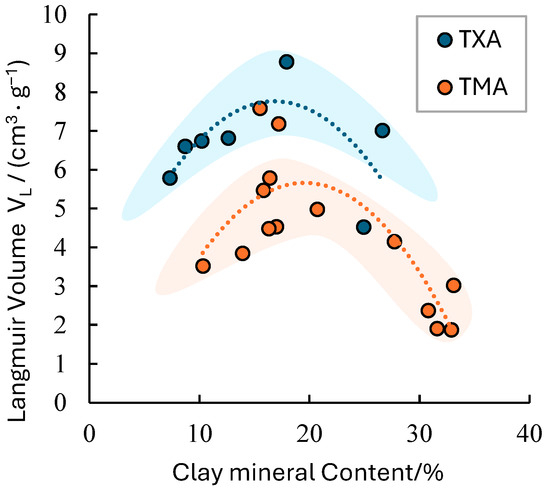
Figure 5.
Adsorption capacity of clay minerals in the shale of the Niutitang Formation.
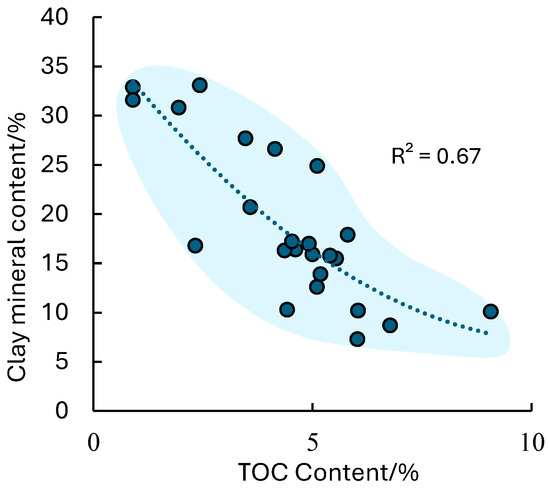
Figure 6.
Relationship between clay minerals and organic carbon content in shale.

Figure 7.
Organic carbon adsorption capacity of the shale of the Niutitang Formation.
Experimental studies by Lu et al. [41] and Kennedy [42] have demonstrated a strong linear positive correlation between the TOC content and methane adsorption capacity. Research and experimental results by Ross [43] and Bustin et al. [44] on Gordondale shale in Canada corroborate these findings, indicating that higher TOC content corresponds to stronger gas adsorption capacity in shale. The higher TOC content in the shale of the Niutitang Formation represents the greater gas adsorption capacity of shale (Figure 7). The organic carbon content is the primary controlling factor for adsorbed gas volume in shale, and the two exhibit a strong positive correlation [28,32].
Effect of mineral composition and organic matter on the gas content: Figure 8 shows that the shale gas content exhibits a strong positive correlation with the TOC content. The symbiotic relationship between authigenic quartz and bituminite under scanning electron microscopy indicates that a significant portion of quartz in the shale of the Niutitang Formation is of biogenic origin. Quartz, like organic matter, is derived from siliceous algae and bacteria. Consequently, the shale gas content shows a strong positive correlation with the quartz content [41].
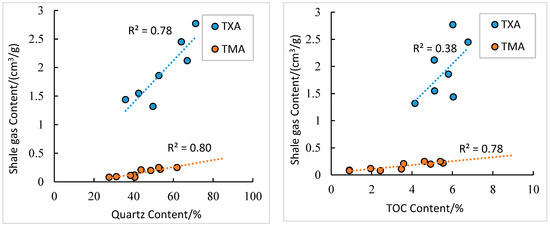
Figure 8.
Relationship between the gas content and compositions of shale in the Niutitang Formation.
4.2. Transformation of the Reservoir by Diagenesis
4.2.1. Diagenestic Types
The diagenetic processes include compaction, cementation, replacement, dissolution, clay mineral transformation, fracturing, and thermal evolution of organic matter in the Niutitang Formation shale of the Cengong Block (Table 3). Compaction and cementation reduce the porosity of the reservoir. In contrast, processes like dissolution, fracturing, and the thermal evolution of organic matter enhance porosity, whereas other processes, such as replacement, have a relatively minor effect on it.

Table 3.
Common diagenetic types of the shale reservoir in the Niutitang Formation.
Based on tectonic movements and geological ages, combined with traditional diagenetic stage division methods [45,46], this study divides the diagenetic field of the Niutitang Formation shale in the research area into three stages: early diagenesis, middle diagenesis, and late diagenesis. Correspondingly, the paleotemperature range for early diagenesis is 20~85 °C, for middle diagenesis is 85~170 °C, and for late diagenesis is higher than 170 °C. The thermal evolution of organic matter within shale is a significant part of the diagenetic process [22]. Kerogen undergoes thermal cracking inside the oil generation window. Formed liquid hydrocarbons are subsequently expelled into neighboring intergranular or intragranular pores. Simultaneously, the volume of kerogen decreases due to hydrocarbon generation, which forms numerous organic pores. Bitumen migrating into intergranular or intragranular pores undergoes secondary cracking within the gas generation window. Then, it transforms into solid bitumen with well-developed pores
4.2.2. Diagenesis and Reservoir Evolution
The analysis of diagenetic stages primarily involves the types and morphology of authigenic clay minerals in shale, the evolution of mixed-layer clay minerals, the maximum pyrolysis peak temperature (Tmax), and the vitrinite reflectance (Ro). The clay mineral assemblage consists of illite (I) and illite/smectite mixed-layer minerals (I/S) in the shale of the Niutitang Formation, with the I/S content being approximately 10%. Based on the X-ray diffraction experiment of clay minerals in samples of Table 2, the average crystallinity of illite is 0.4 and the average content of illite in clay minerals is 87.4%. The characteristics of the clay mineral assemblage and the presence of I/S minerals indicate that shale in the Niutitang Formation has entered the late diagenetic stage. The Ro of shale in the Niutitang Formation ranges between 2.17 and 2.85%, suggesting that organic matter is overmature. Hydrocarbon evolution has reached the dry gas stage, confirming the late diagenetic stage. The Tmax of the shale in the Niutitang Formation generally exceeds 447 °C. The formation has entered the late diagenetic stage, providing favorable geological conditions for the generation and enrichment of shale gas.
Based on the interrelationships of authigenic minerals observed under scanning electron microscopy as well as the formation conditions and diagenetic characteristics of the minerals, the main diagenetic stages and paragenetic sequences of shale in the Niutitang Formation are analyzed as follows (Figure 9) [22,29].
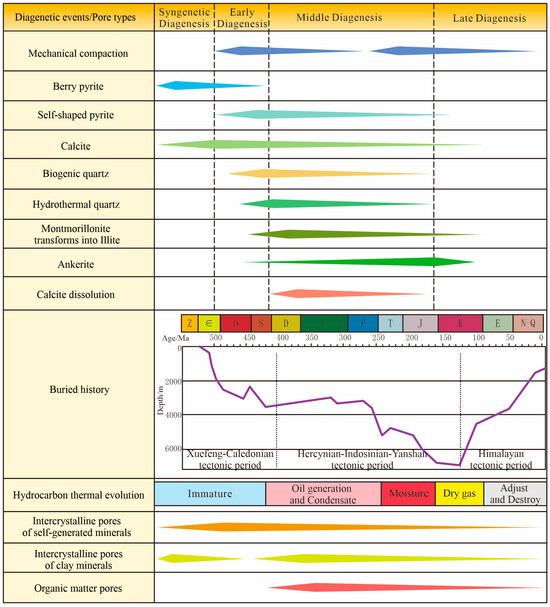
Figure 9.
Diagenetic evolution of shale in the Niutitang Formation in the Cenggong block (Adapted from Liu et al., 2017 and Hu, 2018) [22,29].
Sediments remain in incomplete separation from the water body during the syn-diagenetic stage, where redox conditions significantly influence diagenetic processes. Fine-grained pyrite and micritic calcite are typically formed in deep-water shallow marine sites, with the porosity of argillaceous sediments reaching 50%. As formation pressure increases, argillaceous sediments undergo rapid dehydration during the early diagenetic stage A. The porosity decreases to approximately 30% and stabilizes after the burial depth exceeds 500 m. Organic matter matures and transforms into liquid hydrocarbons with temperatures rising to 60–80 °C in the early diagenetic stage B, which reduces the porosity to about 10%. The transformation of smectite to illite occurs with hydrocarbon generation during the middle diagenetic stage A, which reduces the porosity to 5%–10%. Organic matter reaches high maturity and generates CH4 and CO2 in the middle diagenetic stage B, with the porosity decreasing to approximately 5%. The complete transformation of smectite to illite occurs in the late diagenetic stage. Hydrocarbons become overmature and form dry gas and organic-matter pores, which slightly increases the porosity.
Similarly to other major high-maturity marine shale sites in south China, such as the Wufeng–Longmaxi formations, the thermal evolution of organic matter (reaching Ro > 2.5% in this study) plays a paramount role in generating significant organic porosity, which is crucial for gas storage [1,2]. However, distinct differences in shale gas retention mechanisms may arise from variations in mineralogy and subsequent diagenetic pathways.
For instance, while both systems rely heavily on organic pores and microfractures, the specific interplay observed in the Niutitang Formation between high brittle mineral content (quartz, potentially enhanced by hydrothermal activity as noted in Section 4.3.1) and the diagenetic overprint (including compaction, cementation, and dissolution) influences the development and preservation of fracture networks and matrix porosity differently compared to Wufeng–Longmaxi shales, which can exhibit varying clay mineral assemblages and abundances across different locations [3,22,26]. In the Wufeng–Longmaxi shales, early diagenetic processes, such as the formation of framboidal pyrite, biogenic quartz, and microbial dolomite, established a rigid framework that preserved primary porosity and enhanced brittleness, facilitating microfracture development during later stages. Clay mineral transformations further differentiate these reservoirs. While both formations show illitization of smectite, the Niutitang’s lower clay content reduces ductile deformation risks but limits adsorption capacity.
The documented hydrothermal influence in the Cengong block (Section 4.3.1) further introduces a modification pathway for pore structures and potentially affects thermal maturity locally, adding another layer of complexity to gas storage and preservation mechanisms that might be less pronounced or manifest differently in typical Wufeng–Longmaxi settings. These comparative insights underscore that even within high-maturity shale systems, subtle variations in depositional fabric and diagenetic history, including tectonic and hydrothermal impacts, lead to nuanced differences in reservoir characteristics and ultimate gas retention potential.
Organic matter maturity is an important criterion for evaluating the hydrocarbon generation potential of mud shale. Due to the lack of vitrinite in the marine shale of the Niutitang Formation, it is difficult to directly measure the vitrinite reflectance (Ro). Instead, the reflectance of asphaltenes (Rob) can be used as a substitute. After calibration, the approximate Ro can be obtained. The Ro of shale in the Niutitang Formation ranges between 2.17% and 2.84% (Table 4, Figure 10), suggesting that organic matter is overmature. In organic matter maturity experiments under the microscope, it can be observed that the pure black organic matter has a high maturity, exhibiting an amorphous and formless structure with a uniform texture. With the help of an electron microscope, 10–30 sampling points are selected from each sample for measurement. Figure 10 is the microscope images of the vitrinite particles for measurement and the measured reflectance values are laid out in Table 4. The average Ro of the shale in the Niutitang Formation of the study area is 2.54, indicating that it is in the overmature thermal evolution stage. Hydrocarbon evolution has reached the dry gas stage, confirming the late diagenetic stage. Tmax of the shale in the Niutitang Formation generally exceeds 447 °C. The formation has entered the late diagenetic stage, providing favorable geological conditions for the generation and enrichment of shale gas.

Table 4.
Maturity of organic matter in the shale of the Niutitang Formation in the TXA Well.
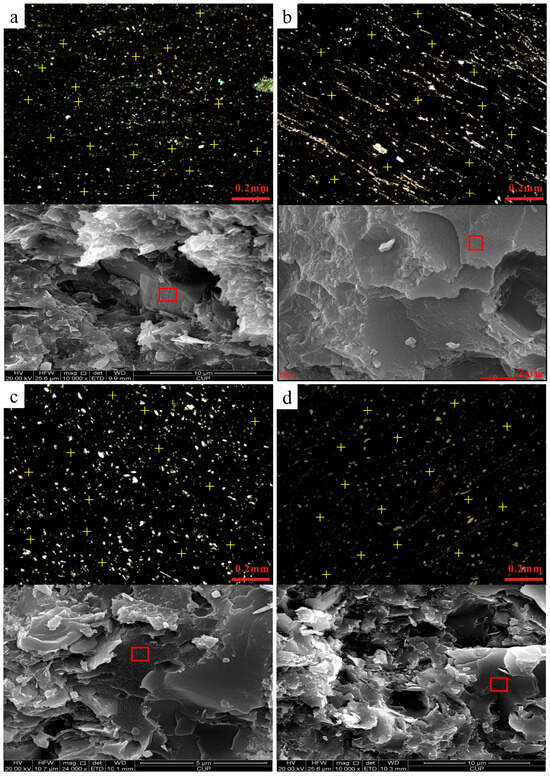
Figure 10.
Microscope images of the measured points on the maturity experiment. (a) TX1-N1-J3, silty carbonaceous shale, depth/m: 1775.56~1775.78; (b) TX1-N1-J1, silty carbonaceous siliceous shale, depth/m: 1783.18~1783.46; (c) TX1-N1-J6, carbonaceous silty mudstone, depth/m: 1800.12~1800.38; (d) TX1-L1-D4, carbonaceous siliceous slate, Laobao Formation, depth/m: 1813.70~1813.72.
4.3. Structural Preservation Conditions Controlling Reservoirs
4.3.1. Influence of Fracture Development on Reservoirs
Fractures directly increase the storage space for shale gas: Based on 2D seismic data in the research area, the TX1 area is located in a broad and gentle saddle-shaped structure sandwiched between anticlines on both the east and west sides, maintaining a considerable distance from major faults and outcrops. Influenced by multi-phase tectonic movements, the research area has developed a fracture system characterized by low-angle (Figure 11a), high-angle (Figure 11b), and network-structure fractures, primarily filled with calcite, argillaceous components, and pyrite. These fractures directly enhance the storage capacity and permeability for shale gas accumulation.

Figure 11.
Characteristics of shale fractures in the Niutitang Formation from Well TX1 in the Cenggong block. (a) TX1 Well (1783.8–1789.4 m): development of subhorizontal low-angle fractures with predominantly carbonaceous fillings along bedding planes; (b) TX1 Well (1783.8–1789.4 m): a subvertical high-angle fracture measuring 0.78 m in length, filled with calcite veins.
Reservoir space and gas-bearing characteristics are significantly affected by fault-associated hydrothermal activities. The research area is surrounded by numerous hydrothermal deposits, predominantly lead–zinc and mercury ores. These mineralizations mainly occur in Cambrian formations, with occasional occurrences in Sinian formations (Table 5) [47]. Peripheral hydrothermal fluids have migrated along fault systems into shale reservoirs, which alters the in situ formation temperature. The elevated temperature of the formation water subsequently affects the diagenetic evolution of both minerals and organic matter, as well as the reservoir space and gas-bearing characteristics of the reservoirs.

Table 5.
Selected hydrothermal deposits in northern Guizhou.
Hydrothermal fluids affect the reservoir space. Hydrothermal fluids have modified the reservoir spaces, and those at the bottom rise along large fractures. Biochemically-derived silica, quartz, and hydrothermal minerals fill and precipitate in secondary small fractures and joint fissures under substantial hydrothermal processes (Figure 12). They offset part of the intense compaction effects from deep burial due to the high hardness of rigid particles (e.g., quartz and silica), which allows the reservoir to retain some porosity [21]. Simultaneously, hydrothermal fluids can promote the overmaturation of organic matter, which increases the number of organic pores.
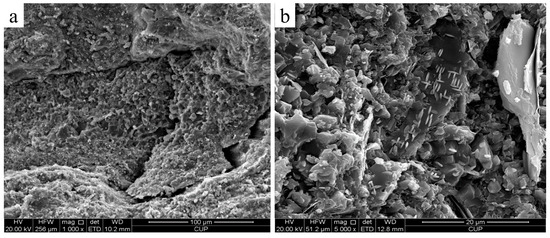
Figure 12.
Hydrothermal mineral-filled fractures in the shale of the Niutitang Formation. (a) Well TMA, 1434.91–1435.19 m, bedding-parallel and oblique bedding fractures, filled with granular silica; (b) Well TMA, 1445.18–1445.47 m, barite and silica closely associated.
Under scanning electron microscopy (SEM), hydrothermal quartz is typically identified within fractures or vugs, displaying well-defined euhedral morphologies (e.g., prismatic hexagonal crystals) with sharp crystal faces, a signature of free growth from high-temperature silica-saturated fluids. Diagenetic quartz manifests as either syntaxial overgrowths on detrital cores (showing truncated crystal faces due to pore-confined growth) or as amorphous/microcrystalline silica cement lacking crystallographic continuity. Detrital quartz grains are distinguished by their rounded to subrounded outlines, surface pitting from mechanical abrasion during transport, and absence of secondary cementation textures, contrasting sharply with the angularity of authigenic/hydrothermal varieties.
The heat transferred by hydrothermal fluids significantly influences the methane adsorption capacity of shale (Figure 13). That is, an increased formation temperature rapidly decreases the gas adsorption capacity of shale [44]. Research on the geological reserves of shale gas in the upper Jurassic Gordondale Formation in northeastern Canada [43] demonstrates that the methane adsorption capacity depends on the formation temperature. The methane adsorption capacity of shale samples decreases as temperature rises at a constant pressure. The impact of temperature on the adsorbed gas volume in deep shale is quite pronounced (Figure 14). The adsorbed gas volumes of shale are 2.9 and 1.4 m3/t at 30 and 90 °C, respectively.
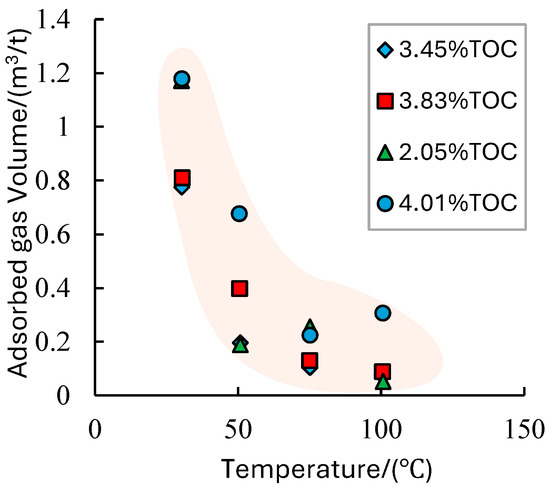
Figure 13.
Relationship between adsorbed gas volume and temperature (Adapted from Jiang, 2018) [48].
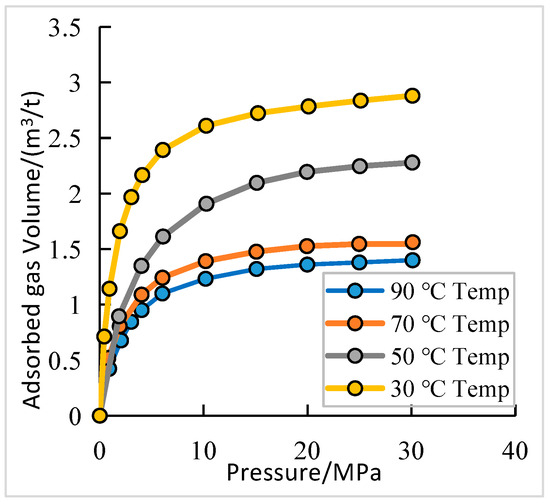
Figure 14.
Isothermal adsorption curves of the shale in the Niutitang Formation under different temperatures (Adapted from Jiang, 2018) [48].
4.3.2. Influence of Roof, Floor, and Formation Pressure
Heterogeneity in the lithology and physical properties of the Niutitang Formation shale in the Cengong block is a prerequisite for its preservation. The breakthrough pressure of mud shale in the Niutitang Formation averages 6.8 MPa, with a maximum of 8.58 MPa. The upper gray silty shale and the lower gray dense siliceous shale of the Niutitang Formation act as direct caprocks for the middle high-carbonaceous shale intervals. Additionally, the overlying of the hundreds-of-meters thick limestone of the Jiumenchong Formation, the lower mudstone of the Bianmachong Formation, and the mudstone of the Balang Formation serve as a roof (Figure 1). It provides a secondary seal and maintains the pressure system of the shale reservoir in the Niutitang Formation. The breakthrough pressure of mud shale in the Bianmachong Formation reaches 10.1 MPa, which prevents the leakage of shale gas.
The underlying dense siliceous rocks of the Laobao Formation and the dolomitic limestone interbedded with mudstone of the Doushantuo Formation act as the floor of the shale gas reservoir in the Niutitang Formation [49]. The internal lithological and physical heterogeneity of the Niutitang Formation, along with its dense roof and floor, provides an effective barrier, preventing the infiltration of surface water and preserving the gas-bearing properties of shale in the Niutitang Formation. Shale gas is preserved in the TX1 area due to its distance from large-scale fractures and its broad, gentle, and stable structural configuration [50].
The formation pressure is governed by the depth and structural closeness. Shale in the lower Cambrian Niutitang Formation in northern Guizhou has undergone multiple phases of tectonic activity. Formations are deformed by high, steep folds, with uplift and erosion resulting in shallow burial depths and well-developed fractures in most areas of the target formation. The depressurization and desorption of shale gas lead to its conversion into free gas and subsequent dissipation into localized areas. However, the TXA area has been less affected by fractures, maintaining favorable structural conditions. The formation pressure system remains intact, which allows for the preservation of adsorbed gas.
Structural conditions influence the formation pressure, which subsequently affects the adsorbed gas content [51]. The adsorption capacity of shale for gas exhibits a positive correlation with pressure within a certain range. Raut et al. [52] proposed that gas adsorption requires a higher binding energy at lower pressures. The required binding energy decreases as pressure increases, which reduces the increased rate of gas adsorption.
Jiang et al. [48] conducted isothermal adsorption experiments, confirming that the adsorbed gas content in the Niutitang Formation shale in the Sichuan basin increases with rising pressure (Figure 15). It is noteworthy that the adsorbed gas content rises significantly with pressure until a critical value of 0.67 m3/t. The increase rate levels off beyond this critical point (Figure 16). Lu et al. obtained similar results using the Langmuir isothermal adsorption model on Devonian shale in the United States [41].
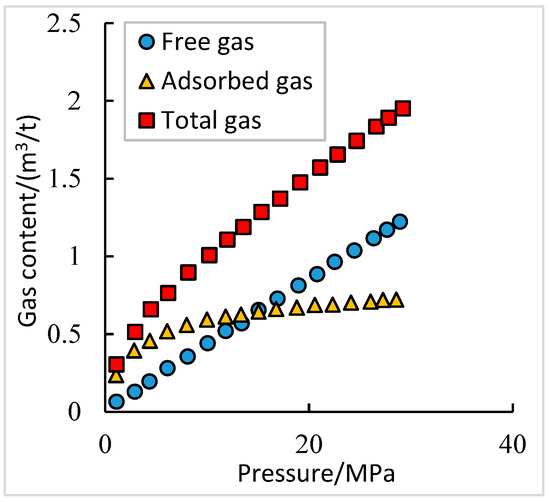
Figure 15.
Relationship between the gas content and pressure (Adapted from Jiang, 2018) [48].

Figure 16.
Isothermal adsorption and desorption curves of shale in the Niutitang Formation at 30 °C (Adapted from Jiang, 2018) [48].
While the three-factor model (sedimentary–diagenetic–tectonic) effectively explains shale gas enrichment in the Niutitang Formation of northern Guizhou, its applicability to other basins requires the careful evaluation of geological contexts. For instance, in regions with lower thermal maturity (Ro < 2.0%) or simpler tectonic histories (e.g., single-phase uplift), the relative importance of diagenetic overprinting and tectonics may diminish, as observed in the Ordos basin analogs, whereas diagenetic models developed for marine shales may not fully translate to lacustrine systems.
Notably, our findings have two uncertainties: The Langmuir volume measurements were conducted at 30 °C and 10 MPa, whereas the actual reservoir temperatures/pressures in deeper sections may reduce adsorption capacities, potentially underestimating gas retention thresholds. The sample set predominantly represents stable structural zones, limiting extrapolation to heavily faulted or uplifted areas where clay mineral plasticity (e.g., illite–smectite ratios > 0.8) and fracture-driven gas loss dominate. Methodological uncertainties stemming from core sampling bias (particularly in fractured zones) and upscaling challenges from millimeter-scale SEM observations to reservoir-scale modeling should be acknowledged. Future work integrating machine learning techniques with multi-scale geological datasets could help quantify these uncertainties and establish probabilistic enrichment criteria across diverse basin architectures.
5. Conclusions
This study integrates connecting micro-scale organic–inorganic matter interactions with overarching macro-scale tectonic controls and diagenetic processes. Recognizing the intricate relationship between the sedimentary features, diagenesis, and tectonic setting is fundamental for optimizing exploration strategies within geologically complex regions. The structural architecture at the basin margin was relatively unfavorable compared to those within the basin due to early, extensive uplift. The shale gas in the Niutitang Formation was derived from the thermal cracking of sapropelic organic matter. Uplift during the Himalayan tectonic cycle resulted in shallower reservoir burial depths and enhanced infiltration of surface water. Therefore, organically generated shale gas was significantly lost. The primary controlling factors for the shale gas reservoirs in the Niutitang Formation in this area included the sedimentary features, diagenetic processes, hydrocarbon generation evolution, and structural preservation conditions.
- (1)
- Sedimentary material formed the foundation for controlling reservoirs and gas content. The organic carbon content was a primary factor governing the adsorption capacity of shale as the higher the TOC of shale, the greater its adsorption capability. The adsorption capacity of shale for methane was also influenced by its mineral composition. A small amount of clay minerals enhanced adsorption capacity, but an excessive content (clay content > 35%) led to a decline.
- (2)
- Diagenesis profoundly altered shale reservoirs. Organic-rich shale in the area has reached the late diagenetic stage. The diagenetic processes included compaction, cementation, replacement, clay mineral transformation, organic matter thermal evolution, and fracturing. Compaction had the most significant impact on the evolution of reservoir porosity.
- (3)
- Structural preservation conditions governed the final occurrence of shale gas. Intense tectonic modifications were unfavorable for the preservation conditions of shale gas reservoirs, whereas milder tectonic activity was conducive. Therefore, favorable preservation conditions typically existed in areas located in the core of structures, farther from formation exposure, and with relatively weaker tectonic intensity.
Looking ahead, a promising avenue for future research involves the synergistic integration of machine learning techniques with comprehensive, multi-scale geological, geochemical, and petrophysical datasets. Such an approach holds considerable potential not only for rigorously quantifying the complex uncertainties inherent in shale reservoir characterization but also for establishing more robust, data-driven probabilistic criteria to predict favorable gas enrichment zones across diverse tectonic and sedimentary basin architectures.
Author Contributions
Conceptualization, D.W.; methodology, L.M.; software, T.Z.; validation, Q.Y.; investigation and resources, J.B.; data curation, C.L.; writing—original draft, D.W., L.M., T.Z., Q.Y., J.B. and C.L.; writing—review and editing, J.P.; project administration, C.A. All authors have read and agreed to the published version of the manuscript.
Funding
This research received no external funding.
Data Availability Statement
The authors confirm that the data supporting the findings of this study are available within the article.
Acknowledgments
We would like to thank Zhang Hui and Lin Bowei, experts from SGS, for providing technical support for the experiment, and Gong Dajian from Tongren Energy Investment Group for providing research data.
Conflicts of Interest
D.W., L.M., and T.Z. are employed by the company China Petroleum and Chemical Corporation and J.B., C.A., and C.L. are employed by the company SINOPEC North China Company. The remaining authors declare that the research was conducted in the absence ofs any commercial or financial relationships that could be construed as a potential conflict of interest.
Abbreviations
The following abbreviations are used in this manuscript:
| TOC | total organic carbon |
| FE-SEM | field emission scanning electron microscopy |
References
- Zhao, W.; Li, J.; Yang, T.; Wang, S.; Huang, J. Comparison and significance of Marine shale gas accumulation differences in southern China. Pet. Explor. Dev. 2016, 43, 12. [Google Scholar] [CrossRef]
- Zou, C.N.; Dong, D.Z.; Wang, Y.; Li, X.J.; Huang, J.L.; Wang, S.F.; Guan, Q.Z.; Zhang, C.C.; Wang, H.Y. Characteristics, challenges and prospects of shale gas in China (1). Pet. Explor. Dev. 2015, 42, 13. [Google Scholar] [CrossRef]
- Guo, X.S. The law of “dual enrichment” of Marine shale gas in Southern China: A practical understanding of shale gas exploration in the Longmaxi Formation of Sichuan Basin and its periphery. Acta Geol. Sin. 2014, 88, 10. [Google Scholar]
- Cao, T.; Xue, H.; Pan, A.; Xiao, J.; Ning, G. Shale gas-bearing capacity and its controlling factors of Wufeng–Longmaxi formations in northern Guizhou, China. Geol. J. 2024, 59, 2772–2788. [Google Scholar] [CrossRef]
- Fan, C.; Nie, S.; Li, H.; Radwan, A.E.; Pan, Q.; Shi, X.; Li, J.; Liu, Y.; Guo, Y. Quantitative prediction and spatial analysis of structural fractures in deep shale gas reservoirs within complex structural zones: A case study of the Longmaxi Formation in the Luzhou area, southern Sichuan Basin, China. J. Asian Earth Sci. 2024, 263, 106025. [Google Scholar] [CrossRef]
- Huang, L.; Xiao, Y.; Yang, Q.; Chen, Q.; Zhang, Y.; Xu, Z.; Feng, X.; Tian, B.; Wang, L.; Liu, Y. Gas sorption in shale media by molecular simulation: Advances, challenges and perspectives. Chem. Eng. J. 2024, 487, 150742. [Google Scholar] [CrossRef]
- Wang, R.; Liu, Y.; Li, Z.; Wang, D.; Wang, G.; Lai, F.; Li, Z.; He, J. Microscopic pore structure characteristics and controlling factors of marine shale: A case study of Lower Cambrian shales in the Southeastern Guizhou, Upper Yangtze Platform, South China. Front. Earth Sci. 2024, 12, 1368326. [Google Scholar] [CrossRef]
- Wang, S.; Man, L.; Wang, S.; Wu, L.; Zhu, Y.; Li, Y.; He, Y. Lithofacies types, reservoir characteristics and silica origin of marine shales: A case study of the Wufeng formation–Longmaxi Formation in the Luzhou area, southern Sichuan Basin. Nat. Gas Ind. B 2022, 9, 394–410. [Google Scholar] [CrossRef]
- Xu, H.; Zhou, W.; Hu, Q.; Yi, T.; Ke, J.; Zhao, A.; Lei, Z.; Yu, Y. Quartz types, silica sources and their implications for porosity evolution and rock mechanics in the Paleozoic Longmaxi Formation shale, Sichuan Basin. Mar. Pet. Geol. 2021, 128, 105036. [Google Scholar] [CrossRef]
- Zheng, Y.; Liao, Y.; Wang, Y.; Xiong, Y.; Peng, P.A. The main geological factors controlling the Wufeng-Longmaxi shale gas content. AAPG Bull. 2022, 106, 2073–2102. [Google Scholar] [CrossRef]
- Chen, K.; Yang, R.; Bao, H.; Dong, T.; Jia, A.; Hu, Q.; Guo, X.; He, S. Depositional-diagenetic process and their implications for pore development of Wufeng-Longmaxi shales in the Jiangdong block, Fuling shale gas field, SW China. Mar. Pet. Geol. 2023, 151, 106177. [Google Scholar] [CrossRef]
- Jiao, W.; Huang, Y.; Zhang, H.; Zhang, Y.; Zhao, D.; Wen, L.; Guo, P.; Zhang, J. Characteristics of Typical Shale Reservoir Development and Its Gas-Bearing Influencing Factors. Chem. Technol. Fuels Oils 2024, 60, 132–141. [Google Scholar] [CrossRef]
- Li, J.; Li, H.; Yang, C.; Wu, Y.; Gao, Z.; Jiang, S. Geological characteristics and controlling factors of deep shale gas enrichment of the Wufeng-Longmaxi Formation in the southern Sichuan Basin, China. Lithosphere 2022, 2022, 4737801. [Google Scholar] [CrossRef]
- Li, M.; Pang, X.; Xiong, L.; Hu, T.; Chen, D.; Zhao, Z.; Hui, S. Application of mathematical statistics to shale gas-bearing property evaluation and main controlling factor analysis. Sci. Rep. 2022, 12, 9859. [Google Scholar] [CrossRef]
- Liu, Y.; Xian, C.; Huang, X. Characteristics of Micro–Nano-Pores in Shallow Shale Gas Reservoirs and Their Controlling Factors on Gas Content. Energies 2024, 17, 1682. [Google Scholar] [CrossRef]
- Memon, A.; Li, A.; Memon, B.S.; Muther, T.; Han, W.; Kashif, M.; Tahir, M.U.; Akbar, I. Gas adsorption and controlling factors of shale: Review, application, comparison and challenges. Nat. Resour. Res. 2021, 30, 827–848. [Google Scholar] [CrossRef]
- Meng, M.; Ge, H.; Shen, Y.; Hu, Q.; Li, L.; Gao, Z.; Tian, T.; Chao, J. The effect of clay-swelling induced cracks on imbibition behavior of marine shale reservoirs. J. Nat. Gas Sci. Eng. 2020, 83, 103525. [Google Scholar] [CrossRef]
- Shi, X.; Wu, W.; Zhou, S.; Tian, C.; Li, D.; Li, D.; Li, Y.; Cai, C.; Chen, Y. Adsorption characteristics and controlling factors of marine deep shale gas in southern Sichuan Basin, China. J. Nat. Gas Geosci. 2022, 7, 61–72. [Google Scholar] [CrossRef]
- Su, H.; Zhang, K.; Nie, H.; Guo, S.; Li, P.; Sun, C. High-quality reservoir space types and controlling factors of deep shale gas reservoirs in the Wufeng–Longmaxi Formation, Sichuan Basin. Energy Fuels 2025, 39, 1106–1125. [Google Scholar] [CrossRef]
- Xiao, X.-M.; Wei, Q.; Gai, H.-F.; Li, T.-F.; Wang, M.-L.; Pan, L.; Chen, J.; Tian, H. Main controlling factors and enrichment area evaluation of shale gas of the Lower Paleozoic marine strata in south China. Pet. Sci. 2015, 12, 573–586. [Google Scholar] [CrossRef]
- Zhang, K.; Peng, J.; Liu, W.; Li, B.; Xia, Q.; Cheng, S.; Yang, Y.; Zeng, Y.; Wen, M.; Liu, D. The role of deep geofluids in the enrichment of sedimentary organic matter: A case study of the Late Ordovician-Early Silurian in the upper Yangtze region and early Cambrian in the lower Yangtze region, south China. Geofluids 2020, 2020, 8868638. [Google Scholar] [CrossRef]
- Hu, Z.Q. The Coupling Mechanism of Shale Gas Source and Reservoir and Its Application; Geological Publishing House: Beijing, China, 2018. [Google Scholar]
- Zhang, H. Scanning Electron Microscopy Study of Unconventional Oil and Gas Reservoirs; Geological Publishing House: Beijing, China, 2016. [Google Scholar]
- Zhao, J.H.; Jin, Z.J.; Lin, C.S.; Liu, G.X.; Liu, K.Y.; Liu, Z.B.; Zhang, Y.Y. Shale sedimentary environment of Lower Cambrian Qiongzhusi Formation in Upper Yangtze region. Oil Gas Geol. 2019, 40, 15. [Google Scholar]
- Li, G.; Xiao, X.; Gai, H.; Lu, C.; Feng, Y. Nanopore structures and controlling factors of the Early Cambrian shale reservoir in the Middle Yangtze Platform, South China. J. Asian Earth Sci. 2023, 254, 105738. [Google Scholar] [CrossRef]
- Liu, Z.B.; Gao, B.; Zhang, Y.Y.; Du, W.; Feng, Y.J.; Nie, H.K. Sedimentary facies types and distribution characteristics of Lower Cambrian shale in Upper Yangtze region. Pet. Explor. Dev. 2017, 44, 11. [Google Scholar] [CrossRef]
- Gi, L.M.; Qiu, J.J.; Zhang, T.W.; Xia, Y.Q. Methane adsorption experiment of main clay mineral components of mud shale. Earth Sci. J. China Univ. Geosci. 2012, 37, 8. [Google Scholar]
- Zhao, Y.; Gao, P.; Zhou, Q.; Xiao, X.; Xing, Y.; Liu, W. A review of the heterogeneity of organic-matter-hosted pores in shale reservoirs. Energies 2022, 15, 8805. [Google Scholar] [CrossRef]
- Liu, J.; Ding, W.; Wang, R.; Yin, S.; Yang, H.; Gu, Y. Simulation of paleotectonic stress fields and quantitative prediction of multi-period fractures in shale reservoirs: A case study of the Niutitang Formation in the Lower Cambrian in the Cen’gong block, South China. Mar. Pet. Geol. 2017, 84, 289–310. [Google Scholar] [CrossRef]
- Zhang, K.; Song, Y.; Jiang, Z.; Xu, D.; Li, L.; Yuan, X.; Liu, P.; Han, F.; Tang, L.; Wang, X. Quantitative Comparison of Genesis and Pore Structure Characteristics of Siliceous Minerals in Marine Shale With Different TOC Contents–A Case Study on the Shale of Lower Silurian Longmaxi Formation in Sichuan Basin, Southern China. Front. Earth Sci. 2022, 10, 887160. [Google Scholar] [CrossRef]
- Li, G.; Gao, P.; Xiao, X.; Lu, C.; Feng, Y. Lower Cambrian Organic-Rich Shales in Southern China: A Review of Gas-Bearing Property, Pore Structure, and Their Controlling Factors. Geofluids 2022, 2022, 9745313. [Google Scholar] [CrossRef]
- Zhao, J.; Jin, Z.; Hu, Q.; Liu, K.; Liu, G.; Gao, B.; Liu, Z.; Zhang, Y.; Wang, R. Geological controls on the accumulation of shale gas: A case study of the early Cambrian shale in the Upper Yangtze area. Mar. Pet. Geol. 2019, 107, 423–437. [Google Scholar] [CrossRef]
- Zhang, L.H.; Tang, H.M.; Chen, G.; Li, Q.R.; He, G.Y. Adsorption characteristics and controlling factors of Lower Silurian Longmaxi Formation shale in southern Sichuan. Nat. Gas Ind. 2014, 34, 63–69. [Google Scholar]
- Wang, M.Z.; Liu, S.B.; Ren, J.J.; Tian, H. Pore characteristics and methane adsorption of clay minerals in shale gas reservoir. Geol. Rev. 2015, 61, 207–216. [Google Scholar]
- Gu, Y.; Wan, Q.; Qin, Z.; Luo, T.; Li, S.; Fu, Y.; Yu, Z. Nanoscale pore characteristics and influential factors of Niutitang formation shale reservoir in Guizhou province. J. Nanosci. Nanotechnol. 2017, 17, 6178–6189. [Google Scholar] [CrossRef]
- Yang, C.; Zhang, J.; Tang, X.; Ding, J.; Zhao, Q.; Dang, W.; Chen, H.; Su, Y.; Li, B.; Lu, D. Comparative study on micro-pore structure of marine, terrestrial, and transitional shales in key areas, China. Int. J. Coal Geol. 2017, 171, 76–92. [Google Scholar] [CrossRef]
- Wang, R.Y.; Hu, Z.Q.; Yang, T.; Gong, D.J.; Yin, S.; Liu, Z.B.; Gao, B. Pore structure characteristics of Lower Cambrian black shale in Cengong area, southeast Guizhou. Exp. Pet. Geol. 2019, 41, 8. [Google Scholar]
- Gai, H.; Li, T.; Wang, X.; Tian, H.; Xiao, X.; Zhou, Q. Methane adsorption characteristics of overmature Lower Cambrian shales of deepwater shelf facies in Southwest China. Mar. Pet. Geol. 2020, 120, 104565. [Google Scholar] [CrossRef]
- Chen, L.; Jiang, Z.; Liu, Q.; Jiang, S.; Liu, K.; Tan, J.; Gao, F. Mechanism of shale gas occurrence: Insights from comparative study on pore structures of marine and lacustrine shales. Mar. Pet. Geol. 2019, 104, 200–216. [Google Scholar] [CrossRef]
- Feng, Y.; Xiao, X.-M.; Wang, E.-Z.; Gao, P.; Lu, C.-G.; Li, G. Gas storage in shale pore system: A review of the mechanism, control and assessment. Pet.Sci. 2023, 20, 2605–2636. [Google Scholar] [CrossRef]
- Lu, X.-C.; Li, F.-C.; Watson, A.T. Adsorption measurements in Devonian shales. Fuel 1995, 74, 599–603. [Google Scholar] [CrossRef]
- Kennedy, M.J.; Pevear, D.R.; Hill, R.J. Mineral surface control of organic carbon in black shale. Science 2002, 295, 657–660. [Google Scholar] [CrossRef]
- Ross, D.J.; Bustin, R.M. Shale gas potential of the lower Jurassic Gordondale member, northeastern British Columbia, Canada. Bull. Can. Pet. Geol. 2007, 55, 51–75. [Google Scholar] [CrossRef]
- Bustin, R.M.; Bustin, A.M.; Cui, X.; Ross, D.; Pathi, V.M. Impact of shale properties on pore structure and storage characteristics. In Proceedings of the SPE Shale Gas Production Conference, Fort Worth, TX, USA, 16–18 November 2008; p. SPE–119892-MS. [Google Scholar]
- Corrado, S.; Schito, A.; Romano, C.; Grigo, D.; Poe, B.T.; Aldega, L.; Caricchi, C.; Di Paolo, L.; Zattin, M. An integrated platform for thermal maturity assessment of polyphase, long-lasting sedimentary basins, from classical to brand-new thermal parameters and models: An example from the on-shore Baltic Basin (Poland). Mar. Pet. Geol. 2020, 122, 104547. [Google Scholar] [CrossRef]
- Schito, A.; Andreucci, B.; Aldega, L.; Corrado, S.; Di Paolo, L.; Zattin, M.; Szaniawski, R.; Jankowski, L.; Mazzoli, S. Burial and exhumation of the western border of the Ukrainian Shield (Podolia): A multi-disciplinary approach. Basin Res. 2018, 30, 532–549. [Google Scholar] [CrossRef]
- Li, P. Analysis of geological conditions and main controlling factors of the constituent reservoir of Niutitang in Cengong shale gas block. In Proceedings of the Excellent Proceedings of the 3rd National Special Gas Reservoir Development Technology Seminar 2014, Chongqing, China, October 2014; pp. 161–169. [Google Scholar]
- Jiang, Z.X. Pore Structure and Gas Bearing Properties of Typical Marine and Continental Shale Reservoirs in China; Science Press: Hong Kong, China, 2018. [Google Scholar]
- Meng, G.; Li, T.; Gai, H.; Xiao, X. Pore characteristics and gas preservation of the Lower Cambrian Shale in a strongly deformed zone, Northern Chongqing, China. Energies 2022, 15, 2956. [Google Scholar] [CrossRef]
- Zhang, K.; Song, Y.; Jia, C.; Jiang, Z.; Han, F.; Wang, P.; Yuan, X.; Yang, Y.; Zeng, Y.; Li, Y. Formation mechanism of the sealing capacity of the roof and floor strata of marine organic-rich shale and shale itself, and its influence on the characteristics of shale gas and organic matter pore development. Mar. Pet. Geol. 2022, 140, 105647. [Google Scholar] [CrossRef]
- Shang, F.H.; Zhu, Y.M.; Hu, Q.H.; Zhu, Y.W.; Wang, Y.; Du, M.Y.; Liu, R.Y.; Han, Y. Characterization of methane adsorption on shale of a complex tectonic area in Northeast Guizhou, China: Experimental results and geological significance. J. Nat. Gas Sci. Eng. 2020, 84, 103676. [Google Scholar] [CrossRef]
- Raut, U.; Famá, M.; Teolis, B.; Baragiola, R. Characterization of porosity in vapor-deposited amorphous solid water from methane adsorption. J. Chem. Phys. 2007, 127, 204713. [Google Scholar] [CrossRef]
Disclaimer/Publisher’s Note: The statements, opinions and data contained in all publications are solely those of the individual author(s) and contributor(s) and not of MDPI and/or the editor(s). MDPI and/or the editor(s) disclaim responsibility for any injury to people or property resulting from any ideas, methods, instructions or products referred to in the content. |
© 2025 by the authors. Licensee MDPI, Basel, Switzerland. This article is an open access article distributed under the terms and conditions of the Creative Commons Attribution (CC BY) license (https://creativecommons.org/licenses/by/4.0/).